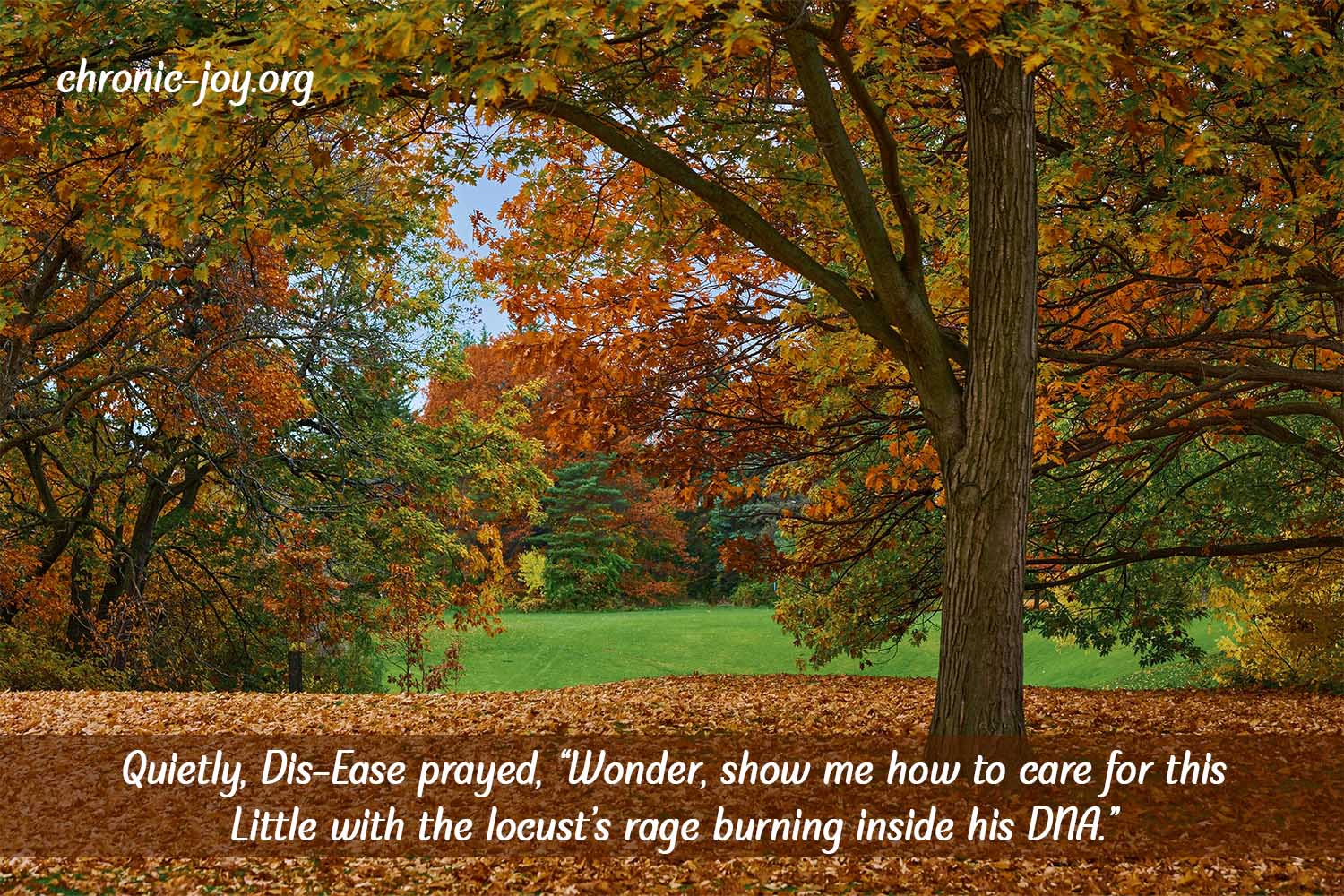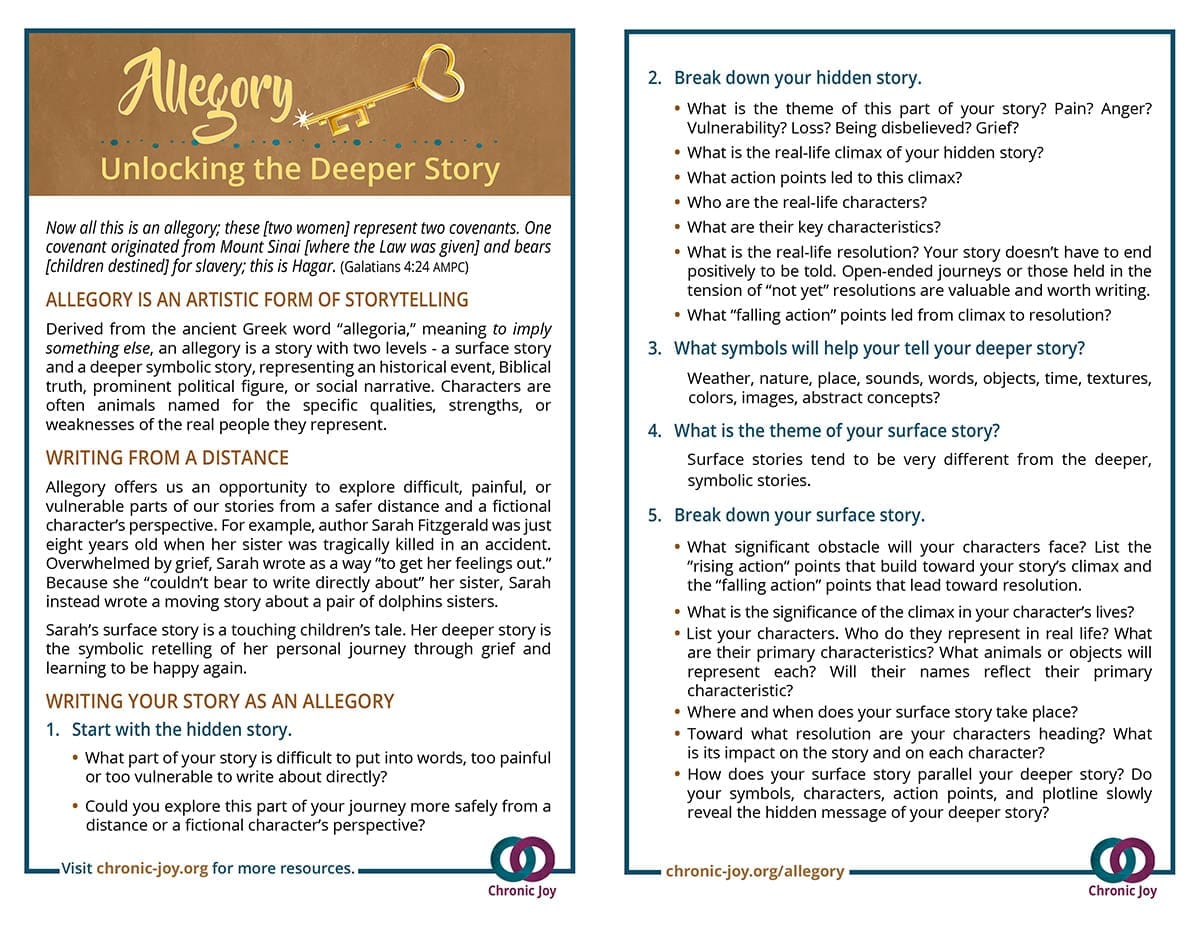
Quietly, Dis-Ease prayed, “Wonder, show me how to care for this Little with the locust’s rage burning inside his DNA.” (Cindee Snider Re)
Days of Jarring Clamor
When the ways of people please the Lord, he causes even their enemies to be at peace with them. (Proverbs 16:7)
“Come on, Dis-Ease! Keep up!”
Little Dis-Ease looked at the ground, tugged at the straps on her backpack, and tried to keep up, but her shoulders hurt, her head pounded, and her legs were so tired. Suddenly, something churned, and she fell to her knees, grasping a small sapling as her stomach emptied its contents.
“Ouch!” cried Dis-Ease as something pricked her ankle.
“DIS-EASE! Get it together and CATCH UP!”
Dis-Ease leaned back on her heels, pushing herself to her feet as she searched the trees for her favorite cinnamon-brown wren. How she longed to sit right here in the sunshine, letting her stomach settle and listening to the little birds sing!—but they were still shouting her name.
“DIS-EASE!”
120 Months Later • Soothed by Soft Rains
There will come soft rains and the smell of the ground / And swallows circling with their shimmering sound… (Sara Teasdale)
Each day, Dis-Ease gathered her Littles and read aloud to them from her favorite poets. Gone were the days of rushing discontent and looming expectations. These were years of soft rain and shimmering sounds. Dis-Ease’s Littles grew strong on the nectar of delight as they splashed in the sparkling springs of curiosity because Wonder walked among them. However, Doom was also slithering in the shadows.
A Plague of Locusts
As summer gave way to autumn, the evening breezes carried a mysterious far-away buzzing interrupted by little clicks and pops. It was unusual, yes, but not alarming.
The days were soft and bright, bubbling with Dis-Ease’s Littles’ delight, discovery, and laughter.
As autumn’s evenings darkened earlier each day, the strange buzzing grew louder, and the clicks and pops came with startling regularity. Unseen, the locusts were gathering at the city gate. By day, they slept, and by night, they gnawed, scraped, and chewed at the gate until one of the locusts broke through. It took wing, like a moth to a flame, headed straight toward the lights of the Littles’ house. It pulled up short and settled on the windowsill, gnawing at the screen. When Inquisitor Little awoke, he found himself face to face with this curious creature.
Inquisitor and the locust watched one another. Fascinated, Inquisitor picked up a pencil and tapped the locust with the rounded eraser. It sidestepped and stopped. Inquisitor tapped it again. Again, the locust sidestepped and stopped. Inquisitor scooched closer. Suddenly, the Locust poked Inquisitor’s finger with a spur. “Ouch,” cried Inquisitor, swatting the locust off the sill.
Five Years in the Wilderness
For one thousand, eight hundred and twenty-five days, Dis-Ease shielded her Littles and prayed, but she was not enough to stave off the poison destroying Inquisitor’s DNA. Doom had whispered of this day, though Dis-Ease had simply turned away. Yet her role had been cast, and her script had been written.
The locust hoard taunted and jeered. “For shame, Dis-Ease! What made you think you could raise these Littles anyway? Don’t you know we poisoned your DNA? Who do you think pricked your ankle that day in the woods when you couldn’t keep up? You’re weak, and you’re worthless, never enough to protect these Littles. You’ll lose them one by one along the way.”
Dis-Ease’s hands shook, her heart pounded, and her stomach churned as a single thought took hold of her soul, and she cried out, “Wonder, help me!”
Dis-Ease felt Wonder’s strength and discovered her courage. “No,” she said, looking the locust leader right in the eye.
“What?” shrieked the locusts.
“No,” Dis-Ease simply said again. “Inquisitor is my Little, and you will not win. You might have poisoned our DNA, but what you meant to harm me has prepared me for this very day.
“Who are YOU to speak to us this way?” the locusts shouted.
The Locusts hissed and screeched until their shrill discordance was quashed in an instant as Wonder spoke, “Silence! Be still!” (Mark 4:39)
The locust hoard trembled.
Wonder continued, “I will restore to you the years that the swarming locust has eaten, the hopper, the destroyer, and the cutter, my great army, which I sent among you.” (Joel 2:25)
The locusts murmured among themselves and took wing, filling the skies and buzzing away.
Autumn Dawns in Shimmering Sounds
Dis-Ease stood next to Inquisitor on a sunny October afternoon, watching her favorite cinnamon-brown wren, enchanted by its effervescent voice.
“Tell me about the wrens,” Inquisitor pleaded. They sat in the shade of the sprawling oak as Dis-Ease began, “These wee little wrens with long white eyebrows and upturned tails are unusually curious, so curious in fact, that they sometimes find themselves down a chimney, on a bus, inside a building, or even flying around the inside of somebody’s home. It’s a good thing they are pocket-sized birds weighing less than four copper pennies in the palm of your hand. “
As they watched, the little wren tossed back its head and sang its two-second song, “Teakettle…teakettle…teakettle. Teakettle…teakettle…teakettle.”
“Inquisitor, did you know that only the male wrens sing?” He shook his head, and Dis-Ease said, “It’s a two-second song he sings almost 3000 times in one day.” Inquisitor laughed.
Dis-Ease leaned back and let the late autumn sun kiss her face before she continued. “Do you remember where the little wren family nested last year?”
“I do! It nested in the garden, in the pockets of the old coat on the scarecrow,” he answered.
Do you know my very favorite thing about these little cinnamon-brown wrens?”
“They are called a chime,” Inquisitor smiled, “and not a flock.”
Dis-Ease pulled Inquisitor close and said, “Yes, their silvery song is like the evening breeze lifting the chimes on our eve.”
Quietly, she prayed, “Wonder, show me how to care for this Little with the locust’s rage burning inside his DNA.”
QUESTIONS FOR THINKING ABOUT WRITING YOUR STORY IN ALLEGORY
- What would you name yourself in an allegory? What would you name others in your story? (This, for me, was one of the most challenging aspects of beginning to tell our story in allegory.)
- Could a creature, weather condition, or circumstance help you describe your illness or pain?
- How would you name and describe God?
- Where would your allegory be set? Is there a place you can name and describe?
- What moment stands out as a place to begin? Consider writing your allegory in parts or chapters.
A TIP
Find one person who would be willing to read your allegory and give you feedback. Perhaps both of you could write your stories in allegory and encourage one another along the way. Happy writing!


Cindee Snider Re
Author, Designer, and Co-Founder of Chronic Joy®
Cindee is married to the man she loves most in this world, mama to five adult kids, four of whom are married, and Lolli to an adorable grandson. Cindee and her five kids have Ehlers-Danlos, intractable migraines, and myriad co-existing conditions. While a life steeped in illness is not what she would have chosen, through it, she’s learning that the deeper the valley, the greater her capacity for joy.
Cindee is the author of Discovering Hope, Finding Purpose, Embracing Worth, and I Take You in Sickness and in Health.

Allegory • Symbolic Storytelling
Allegory is a beautiful, artistic form of storytelling that allows us to explore difficult, painful, or vulnerable parts of our stories from a safer distance and a fictional character’s perspective.

Recent Comments